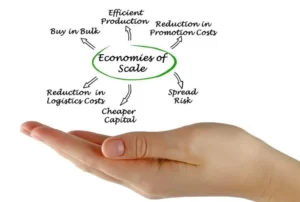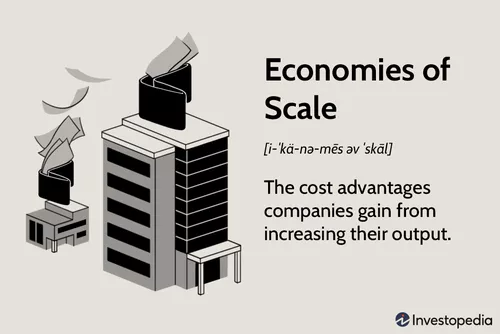The economy of scale is the concept that when a firm becomes larger, it uses fewer resources to produce a given quantity. The benefit to a producer is that he or she reduces production costs, which means profits go up.
Economies of scale are usually associated with industrial companies that operate on a mass basis. For example, if you’re manufacturing a product and you decide to increase the number of products you’re making, you can save time and energy by increasing your output.
There is also a cost saving effect. If the company you work for produces more than two million pairs of socks every year, there will be economies of scale in play since you don’t need to spend all day sewing them.
The most important thing to remember about economies of scale is that they are not automatic. You have to actively pursue economies of scale.
What Is Economies of Scale in Simple Terms?

Economics of Scale – Economies of scale refer to the benefits that come from producing more output at a lower cost. For example, the production of a large number of widgets can reduce the overall costs of manufacturing them.
In general, the larger the volume of goods produced, the less expensive the per unit price. The reason why this happens is because the fixed costs associated with producing each widget are spread across the entire quantity of widgets being manufactured. This means that the marginal cost (the additional cost required to produce one more item) is reduced as well.
The term ‘economy of scale’ was first used by British economist Alfred Marshall in his book Principles of Economics. He defined it as “a tendency for the rate of return to be highest when the size of a firm’s operations is largest.”
It is important to note that the economies of scale effect applies to all firms, not just manufacturers. Small businesses can also benefit from the advantages of economies of scale.
What Are the 4 Economies of Scale?
There is a lot to know when you’re starting your own business. One of the most important things that you need to learn is how to manage money. If you want to make sure that you have enough money to support yourself, then you’ll need to understand the four different kinds of economies of scale.
Economies of Scale
First, let’s look at the first economy of scale. This type of economy of scale refers to the fact that businesses tend to become more efficient as they grow larger. As a company grows, it will be able to produce more goods and services. The amount that each worker produces goes up.
Second Economy Of Scale
Next, we’ve got the second kind of economy of scale. In this case, companies get better at producing certain products as their size increases. For example, the price of a car tends to go down with the number of cars produced.
Third Economy Of Scale
Then there’s the third kind of economy of scale. With this one, you can see that bigger companies are usually able to charge higher prices than smaller ones.
What Are Examples of Economies of Scale?
Economies of scale are a concept that was first introduced by economist Alfred Marshall. This is the idea that large businesses can be more efficient than small companies. The main benefit of this type of business model is that they produce less waste.
Alfred Marshall came up with the theory after he noticed how much money certain industries were making. For example, railways made a lot of profit because they could charge high prices for their services. However, these profits weren’t evenly distributed. Some railway lines had no passengers at all. So, instead of losing money, they actually turned a profit.
If you’re wondering why we need to know about economies of scale, then keep reading. You’ll learn some useful information that will help you make better decisions in the future.
One thing that you should understand is that there are two different kinds of economies of scale. There’s horizontal and vertical economies of scale. Horizontal economies of scale refers to the fact that larger firms can save a lot of time, energy, and resources.
What Are the 7 Economies of Scale?
In the world of business, there is a concept known as “economies of scale.” This means that companies can produce more products at less cost when they have large volumes of sales. For example, you might know that McDonald’s sells hamburgers for $1.00. However, if you look around, you’ll notice that other fast food restaurants sell them for a lot more than this.
This happens because these businesses can use their size to negotiate better deals with suppliers and distributors. As a result, they can charge customers much lower prices.
If you’re interested in learning more about how economies of scale work, then the article below will help. The following are seven examples of what you should know.
Economies of Scale Example 1. When you buy a pair of shoes, you usually pay for the materials and labor that go into making the product. If the company makes thousands or millions of pairs of shoes, it doesn’t need to spend as much on each one. Instead, they can cut costs by paying workers less money.
What Are the 6 Types of Economies of Scale?
Economics is a field of study that involves understanding how markets work. One part of this process is figuring out the different ways in which businesses can make money.
There are six main types of economies of scale. The first type is vertical integration, where the company owns its own production facilities. This means that the business can produce more products at lower costs.
Another form of economy of scale is horizontal expansion. A company expands into other areas by acquiring another firm. This allows them to expand their market share.
A third way to increase profits is to reduce costs. Companies can do this through reducing the number of employees, cutting down on the amount of capital they use, and improving efficiency.
The fourth way that companies can boost their earnings is by increasing productivity. This happens when workers become smarter, faster, or more efficient.
The fifth method for boosting revenues is to improve customer service. If a business offers better services, then it can charge higher prices.
Finally, the sixth and most important way to grow your bottom line is to cut back on expenses.
What Are the 5 Internal Economies of Scale?
If you want to learn more about the concept of internal economies of scale, then you should check out the article below. This is a guide that explains how these concepts can help you improve your business.
When you’re running a small company, it’s important that you have an understanding of the five different kinds of economies of scale. Here are the five main points.
1. Internal economies of scale: The first kind of economy of scale refers to the fact that larger companies tend to be able to make better decisions than smaller businesses. If you’re a large corporation, you can get away with making mistakes because you don’t really care whether or not you lose money.
2. External economies of scale: This is a situation where a firm benefits from being bigger. For example, if you own a chain of restaurants, then each restaurant will likely benefit from the fact that you have many other locations.
3. Cost-reducing specialization: As your company grows, you’ll find yourself specializing in certain areas.
Economies of Scale Ap Human Geography
Economics is a complex subject. For most students, economics isn’t the easiest thing to understand. That’s why this article explains how economics works. You’ll learn more about the concept of economies of scale and the importance of geographic location.
One of the biggest challenges that college students face when studying economics is understanding the concepts behind supply and demand. This article will help you gain an understanding of these two basic economic principles.
Supply and Demand
When you look at a product, you’re usually looking at the amount of units available in the market. If you have a limited number of products to choose from, then you might be interested in buying them all up. However, when there are many different options for the same item, it becomes harder to buy everything that you want.
In order to make sure that you don’t run out of supplies, companies try to keep their prices low. In other words, they lower the price of each unit so that customers will buy more of the items.
This is where the concept of supply comes into play.
Economies of Scale Diagram
Economics is the study of how society allocates resources to meet its needs. Economists have developed a number of models to explain the allocation of these resources. One model that is particularly useful to understand is the economic theory of supply and demand. This concept helps us to understand why prices change in different markets.
Supply-and-demand diagrams are used to illustrate this idea. The first step involves drawing a horizontal line across the graph. Then, economists draw another vertical line at the intersection of the two lines. Finally, they connect the points where the two lines cross.
The resulting figure shows how much of a product is available and the price that consumers will pay for it. If the cost of producing the good falls, then the amount of goods produced increases. As a result, there’s more to go around, so the price goes down.
If the costs rise, however, fewer products are made, so less is available. Because of this, people will be willing to spend more money for the same quantity of the product.
Economies of Scale Graph
Economies of Scale: And Economies Of Scale Graph
You have probably heard of the concept of economies of scale before. If you haven’t, you might want to read this article to learn more.
In a nutshell, an economy of scale is the idea that the cost of producing goods and services decreases as the quantity produced increases. For example, let’s say that you need to buy 10,000 widgets. The first thing you would do is hire someone to make them for you. You will pay him $10,000 to do so. Now, you could also produce the same number of widgets yourself. This time, however, you’ll spend $100,000. In other words, the price of making the widgets has gone up by a factor of ten.
This is why it is important to use economies of scale when possible. When you can save money, you should do so.
If you’re interested in learning how much you can save, then you may be able to find some helpful information on the Internet. However, there are many factors that affect your savings rate.
Economies of Scale Occur When
Economies of scale occurs when a business is able to produce more output at a lower cost. For example, a large company might be able to make more widgets than a small one. Economies of scale can also happen within an individual firm. If you have a larger workforce, you can increase productivity by hiring additional workers.
If your company has been growing, you should expect that you will eventually reach a point where you need fewer employees. This means that you can save money on wages.
You can use this savings to invest in new equipment or expand into other areas of the market.
In addition, economies of scale are important for any organization that wants to reduce its operating costs. A smaller size allows you to buy products or services at a cheaper price.
For instance, a family-owned restaurant may want to cut down on labor costs. By hiring part time help instead of full-time staff, they can keep their prices low and still provide quality service.

